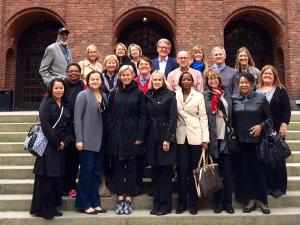By Sue Letourneau, Center for Prevention at Blue Cross and Blue Shield of Minnesota, and Pam Bishop, Southern Minnesota Initiative Foundation
There is strong legacy of creative work and collaboration between Minnesota’s funding community and hunger relief organizations and coalitions that have led to real impact. As funders who work at the intersection of food, health, and hunger, we see exciting work ahead that builds upon this foundation. New initiatives, ways of thinking, and compelling work on the ground are emerging at state and national levels.
If we look back at what’s been set in motion, we see examples of on-the-ground creativity coupled with state government’s commitment to move the dial on health and equity. The progress resonates with a new initiative at the Robert Wood Johnson Foundation that emphasizes creating a culture of health—one that “enables all in our diverse society to lead healthier lives, now and for generations to come.”
The Minnesota Department of Health has provided substantial investments around healthy eating and leadership as a state agency on eliminating health disparities and advancing health equity. The Governor’s office has facilitated a memorandum of agreement, signed by all state agencies, to meaningfully address equity in its programs, policies, and systems.
Many funders in the arenas of health and hunger have funded new initiatives —individually and in partnership—focused on increasing access to culturally responsive, healthy food where people get and buy food: hunger relief programs, institutional foodservice, food delivery programs, SNAP/EBT acceptance at farmers markets, and food retail. Other healthy eating initiatives across the state have added fresh produce at food shelves, established healthy food policies at hunger relief programs, and ensured that corner and convenience stores offer affordable, healthy options.
All this momentum in our state shows a shared commitment to ensuring all Minnesotans have reliable access to safe, affordable, healthy food. It also indicates a rising awareness that Minnesota’s racial disparities in health, income, and educational attainment require swift, sustained, and systemic action by a consortium of partners.
The convergence of health in all policies to advance health equity and integrate healthy food access and hunger relief provides Minnesota’s funding community with an exciting framework for future collaboration and systems change.
On January 20, the Minnesota Food Funders Network—in partnership with Greater Twin Cities United Way and the Minnesota Hunger Initiative—hosted an event: “Issue Brief: The Impact of Access to Healthy Food on Health Equity.”
More than 100 funders and program staff from across Minnesota came together for a half-day session, with presentations from the Minnesota Commissioner of Health, Ed Ehlinger; the Minnesota Assistant Commissioner of Human Services, Anne Barry; Director and Advisor of Chief Executive Officer, Robert Wood Johnson Foundation, Dr. Dwayne Proctor; and other speakers from the Wilder Foundation and innovative programs from across Minnesota.
This event wove together important conceptual frameworks, new ways of thinking and collaborating, and success stories. As event co-chairs, we anticipate strategic new collaborations among funders and partners to implement policy and systems changes that advance health equity, reduce hunger, and increase healthy food access. We look forward to a future of dynamic work that builds the local and regional food infrastructure that ensures healthy food environments and promotes healthy food skills for all.
As a follow-up to the event, MFFN will host a 2nd quarter meeting to explore opportunities for strategic alignment and partnership among interested parties.
Our past, current, and future work at the intersection of hunger, health, and food are an important part of the shared roadmap of 99 policy and systems changes identified by thousands of Minnesotans in the Minnesota Food Charter. With many proven, actionable strategies that address hunger, health and equity, Food Charter strategies are a great way to move the dial on health and hunger for our state. This convening, the Minnesota Food Charter, and the rich array of current and potential efforts can support our collective efforts to make meaningful progress on these important issues.
—
The Minnesota Food Funders Network is a group of Minnesota-based funders who make informed, coordinated, and strategic investments to improve key facets of our food system. Our partnership supports learning, networking, and strategic alignment among funders who have a shared commitment to the vitality and prosperity of our state’s communities and resilience of our landscapes inspire us to work together.
If you’re interested in getting involved:
- Join the MFFN Listserv by contacting Katina Mortenson (kmortensen@mcf.org), Program Manager at the Minnesota Council on Foundations
- Attend future MFFN public meetings like this one. You can keep informed through the listserv and at Minnesota Council on Foundation’s website at http://www.mcf.org
- Contact one of us to become a member of the Minnesota Food Funders Network (Letourneau@bluecrossmn.com or Amy.Lopez@gtcuw.org)



 Posted by MCF Webmaster
Posted by MCF Webmaster ![2015 Trends: How Digital and Social Media Have Transformed Nonprofits [Infographic]](https://i0.wp.com/www.mdgadvertising.com/blog/wp-content/uploads/2015/11/2015-Trends-How-Digital-and-Social-Media-Have-Transformed-Nonprofits-475.jpg)







